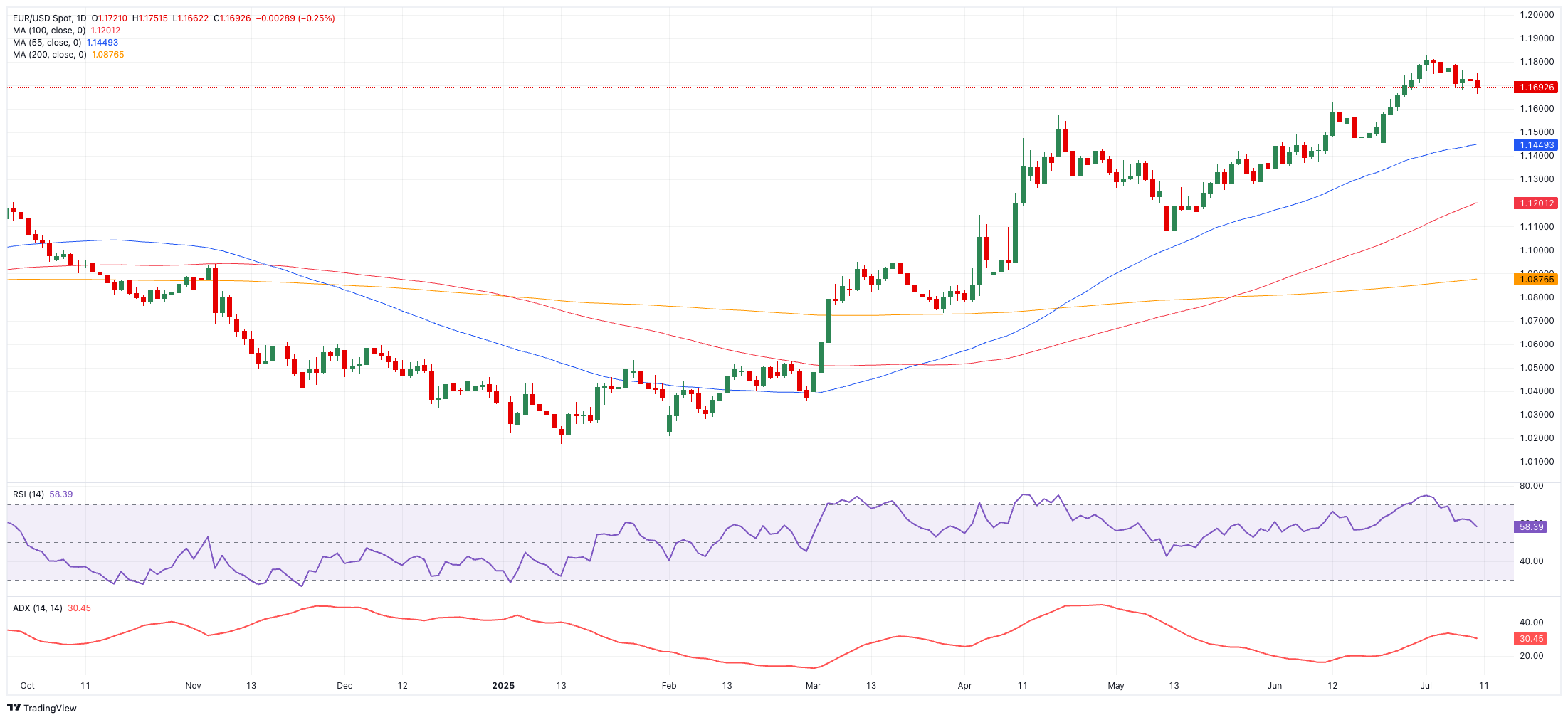
- EUR/USD lost further ground and receded to two-week lows near 1.1660.
- The US Dollar reversed recent losses and traded with decent gains.
- Investors remained wary of the trade policies from the White House.
The Euro (EUR) edged lower against the US Dollar (USD) on Thursday, dragging EUR/USD to fresh two-week troughs in the 1.1660 region as investors remained watchful of the trade front and the potential escalation of the tariff narrative.
Geopolitical relief proves fleeting as trade jitters resurface
An early boost to market sentiment from a US-brokered ceasefire in the Middle East faded quickly as fresh trade worries gripped investors.
While the White House delayed the next tariff review until August 1, Monday’s announcement of sweeping new levies—25% on Japanese and South Korean goods and 50% on copper imports—rekindled fears of escalating trade hostilities. Against that backdrop, the Greenback found support in response to renewed demand for safe havens.
Meanwhile, there was still little sign of movement towards a possible US-EU trade deal. Both parties have shown desire in a deal, but conversations haven’t led to anything yet, which makes the markets nervous.
Policy differences on hold
In June, the Federal Reserve (Fed) kept its target rate at 4.25%–4.50% while boosting its predictions for inflation and jobs. Minutes from the meeting, which came out last Wednesday, showed that the Committee was split. Some members wanted a quick rate decrease, but most wanted to wait since they weren’t sure how additional tariffs would affect inflation.
Still, most people agreed that some easing would probably be necessary later this year, particularly if inflation turns out to be temporary, as many policymakers think it will be.
The European Central Bank (ECB), on the other hand, cut its Deposit Facility Rate to 2.00% in early June. Christine Lagarde, the president of the European Central Bank, said that any action would rely on convincing indicators of poor external demand, which suggests that there isn’t much interest in cutting rates in the near future.
Speculators still favour the Euro
CFTC data show net speculative long positions in the European currency easing slightly to around 107.5 contracts. At the same time, commercial players, mainly hedge funds, trimmed net shorts to around 160.6K contracts. Furthermore, open interest climbed to a three-week high of nearly 779K contracts, indicating sustained interest in the currency.
Data watch
Germany’s Wholesale Price index and EMU current account figures will wrap up the domestic calendar on Friday.
Technical setup
Resistance sits at the 2025 high of 1.1830 (July 1), followed by the June top at 1.1852 (June 2018).
On the downside, provisional support is seen at the 55-day simple moving average (SMA) at 1.1447, ahead of the weekly trough at 1.1210 (May 29) and the May valley at 1.1064 (May 12), all preceding the key 1.1000 milestone.
Momentum indicators continue to suggest a robust Euro. The Relative Strength Index (RSI) is close to 59, which means the market is bullish. The Average Directional Index (ADX) is close to 31, indicative that the strength of the trend is moderating.
EUR/USD daily chart

Outlook: The uptrend is still going strong
Risk sentiment is slowly becoming better, and the Fed is expected to lower rates later this year. This might cause the EUR/USD to start going higher again. But ongoing trade tensions and the uncertainty of President Trump’s tariff policies still pose significant threats that might halt additional increases in the near future.
Euro FAQs
The Euro is the currency for the 19 European Union countries that belong to the Eurozone. It is the second most heavily traded currency in the world behind the US Dollar. In 2022, it accounted for 31% of all foreign exchange transactions, with an average daily turnover of over $2.2 trillion a day. EUR/USD is the most heavily traded currency pair in the world, accounting for an estimated 30% off all transactions, followed by EUR/JPY (4%), EUR/GBP (3%) and EUR/AUD (2%).
The European Central Bank (ECB) in Frankfurt, Germany, is the reserve bank for the Eurozone. The ECB sets interest rates and manages monetary policy. The ECB’s primary mandate is to maintain price stability, which means either controlling inflation or stimulating growth. Its primary tool is the raising or lowering of interest rates. Relatively high interest rates – or the expectation of higher rates – will usually benefit the Euro and vice versa. The ECB Governing Council makes monetary policy decisions at meetings held eight times a year. Decisions are made by heads of the Eurozone national banks and six permanent members, including the President of the ECB, Christine Lagarde.
Eurozone inflation data, measured by the Harmonized Index of Consumer Prices (HICP), is an important econometric for the Euro. If inflation rises more than expected, especially if above the ECB’s 2% target, it obliges the ECB to raise interest rates to bring it back under control. Relatively high interest rates compared to its counterparts will usually benefit the Euro, as it makes the region more attractive as a place for global investors to park their money.
Data releases gauge the health of the economy and can impact on the Euro. Indicators such as GDP, Manufacturing and Services PMIs, employment, and consumer sentiment surveys can all influence the direction of the single currency. A strong economy is good for the Euro. Not only does it attract more foreign investment but it may encourage the ECB to put up interest rates, which will directly strengthen the Euro. Otherwise, if economic data is weak, the Euro is likely to fall. Economic data for the four largest economies in the euro area (Germany, France, Italy and Spain) are especially significant, as they account for 75% of the Eurozone’s economy.
Another significant data release for the Euro is the Trade Balance. This indicator measures the difference between what a country earns from its exports and what it spends on imports over a given period. If a country produces highly sought after exports then its currency will gain in value purely from the extra demand created from foreign buyers seeking to purchase these goods. Therefore, a positive net Trade Balance strengthens a currency and vice versa for a negative balance.
Information on these pages contains forward-looking statements that involve risks and uncertainties. Markets and instruments profiled on this page are for informational purposes only and should not in any way come across as a recommendation to buy or sell in these assets. You should do your own thorough research before making any investment decisions. FXStreet does not in any way guarantee that this information is free from mistakes, errors, or material misstatements. It also does not guarantee that this information is of a timely nature. Investing in Open Markets involves a great deal of risk, including the loss of all or a portion of your investment, as well as emotional distress. All risks, losses and costs associated with investing, including total loss of principal, are your responsibility. The views and opinions expressed in this article are those of the authors and do not necessarily reflect the official policy or position of FXStreet nor its advertisers. The author will not be held responsible for information that is found at the end of links posted on this page.
If not otherwise explicitly mentioned in the body of the article, at the time of writing, the author has no position in any stock mentioned in this article and no business relationship with any company mentioned. The author has not received compensation for writing this article, other than from FXStreet.
FXStreet and the author do not provide personalized recommendations. The author makes no representations as to the accuracy, completeness, or suitability of this information. FXStreet and the author will not be liable for any errors, omissions or any losses, injuries or damages arising from this information and its display or use. Errors and omissions excepted.
The author and FXStreet are not registered investment advisors and nothing in this article is intended to be investment advice.








